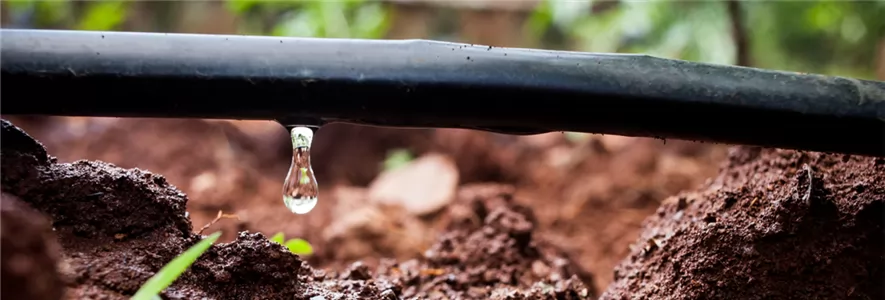Drip Irrigation, an Israeli invention, allows dry land to produce crops to feed a hungry world.

Irrigation breaks down into three main categories: flood irrigation, sprinkler irrigation and the method that Netafim pioneered, drip irrigation. Flood irrigation (essentially pouring water on crops) accounts for almost 80% of the irrigation that's done on farms, it's harmful to soil (the water pushes the soil all over the place) and water sources, produces diminished yields, and is wildly wasteful. The sprinkler family of irrigation devices – used for about 15% of farm irrigation – is a bit better than flood irrigation in terms of efficiency, but that's not saying much. Bringing up the rear in terms of usage is drip irrigation, which is the method of choice for about 5% of farms. But it is the unquestionable state of the art in terms of efficiency and its ability to squeeze the most productivity out of every drop of water.
Estimates of the water savings drip irrigation provides vary, largely because watering conditions vary, but they come down between twenty and fifty percent over sprinklers, the next most efficient method. In other words, when it's really working right, drip irrigation can effectively double your water supply.
Israel isn't the #1 driest country on earth. So Israel has more than a bit of history with irrigation. And from the beginning, it was always a matter of moving water around and then turning on the spigot. In the 1930s, a water engineer by the name of Simcha Blass was visiting a friend in the desert when he noticed a line of trees with one member that was noticeable taller and more robust looking than the others. He did a little digging, literally, and noticed that a household water line running along the tree line had spring a small leak in the area of that one tree and as feeding it with a steady drip drip drip of water. The wet spot on the surface didn't seem like much, but down below was a large onion-shaped area of juicy soil.
The idea of drip irrigation was born.
Mr. Blass partnered with Kibbutz Hatzerim in the Negev desert to develop entire drip irrigation systems. He tinkered with variations on the idea, but when plastics became widely available in the 1960s, he finally had the ability to put drops of water precisely where he wanted, when he wanted; Mr. Blass and the kibbutz founded Netafim.
Since then, Netafim has sold its systems in more than 100 countries worldwide. The more we ask of our planet's limited water supply, the more drip irrigation systems will benefit the world. Water has been declared to be a basic human right but we squander it with wasteful irrigation. Drip irrigation provides the ability to make water work harder and more productively than its ever done in the past. If 15% of farms using conventional irrigation switched to drip irrigation, the supply of water available for domestic use would double.
That statistic alone should make the world take notice. But drip irrigation systems do a lot more than just move water around the farm. We're not just talking about a hose with a hole. The system is very sophisticated, because you need to make sure that the plants that are far from the valve get the same amount as the plants that are close to the valve. You have to be able to maintain consistency in a system that runs uphill, that runs downhill…Inconsistency equals waste, and the goal is to eliminate waste.
In the 1960s, we were using plain drinking water. Today we use recycled water, waste water, brackish water…and we’re adding nutrients mixed in with the water, so that, in a way, what we’re really doing isn’t irrigation, it's 'fertigation.'
Dirt, nutrients, waste – all of this business going on in the water is what makes controlling it so tricky. And this is where the ingenuity of Netafim comes in – in the valves that control the actual drops of water. The valves are spaced precisely along the irrigation lines, and they must work in concert with one another. These valves are what make the system work. They are anti-clogging, self-cleaning, very sophisticated little mechanisms. They make it possible to get greater crop yields, greater crop control, while using significantly less water than we did just a few decades ago.
How much less? In 1965 a typical drip irrigation system could use anywhere from two to four liters of water per hour, which was a vast improvement from the prevailing flood irrigation system. But now, a typical drip irrigation system will use half a liter per hour…and Netafim is still trying to get that number down. The main reason is simple: In the next 100 years we are going to have to produce more crops than we ever have, with far less environmental damage than we're doing now.
Some are well on the way to achieving that goal. About 75 percent of Israeli farming is done with drip irrigation, with practically no flood irrigation at all. Drip irrigation accounts for about half of irrigation in California; South Africa is also a big user. But other areas of the world have yet to make the shift – and food is only one of the reasons why it’s important for them to do so. Because when you really dig in to the nuances of drip irrigation, you start to see how widespread its ramifications are.
For example, by using water more efficiently, drip irrigation means you use less fertilizer. Fertilizer production is a significant source of greenhouse gas emissions. Likewise, the growing market for biofuels will benefit from drip irrigation through the reduced cost of raising fuel crops. which will in turn aid in the spread of biofuels, which will reduce the production of greenhouse gasses, which will, in the long run, reduce the pressure on the world’s water supplies.



